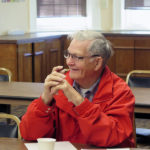By Anne Marie Amacher
The Catholic Messenger
DAVENPORT — People within the Diocese of Davenport will experience the Aug. 21 solar eclipse at 90 percent or more coverage. The entire U.S., including Alaska and Hawaii, as well as all of Canada and Mexico, will experience at least a partial eclipse to some degree.
Robert Mitchell, professor of engineering and physical science at St. Ambrose University, will conduct a live broadcast from Aurora, Neb., where a total eclipse will occur. The broadcast will appear live at the Putnam Museum in Davenport and will be livestreamed for showing on YouTube.
He said a full eclipse across the Davenport Diocese has not occurred in centuries. The last solar eclipse to sweep across the United States from west to east was June 8, 1918. And the last one on the U.S. mainland was Feb. 26, 1979. Other eclipses have occurred in the U.S., but not crossing the entire country, he noted. An annular eclipse — where the moon doesn’t cover the entire sun and has a halo look — appeared in 1991.
“This is a really rare event,” Mitchell said of the upcoming total solar eclipse. According to Catholic News Service, a total solar eclipse occurs every 18 months on average somewhere on the earth.
An eclipse occurs when the moon’s orbit puts it directly in front of the sun and casts a shadow on the earth. The moon’s orbit varies each month, which is why it does not happen every month.
Mitchell contacted the Edgerton Explorit and Leadership Center in Nebraska, about 20 miles east of Grand Island, Neb. This spot is in line for the total eclipse. He and a team from the Quad-Cities will head out Aug. 20 to do their setup. The live broadcast will begin at 11 a.m. Aug. 21 with talks and PowerPoint presentations and then a presentation of the eclipse as it happens.
Besides wanting to experience the total eclipse, Mitchell hoped to share the extraordinary event with others back in Iowa. “The Putnam was very keen on doing this. They are providing their big screen to show our webcast,” he said. The Putnam event runs from 11 a.m. to 2 p.m. in the theater.
Dale Hendricks, past president of the Quad City Astronomical Society, will give a talk at the Putnam, prior to the livestreaming.
During the eclipse, experts will provide explanations of what is happening, Mitchell said. Outside the Putnam, an area will be set up to witness the partial, but nearly total, eclipse in the Quad-City area.
Mitchell said people will start seeing the sky darken around 11:45 a.m. The maximum part of the eclipse will be visible around 1:15 p.m. It will be dark like night in Aurora, Neb., but not in the Quad Cities.
He reminds viewers not to look directly at the sun at any point, even when it is almost covered. “Wear proper viewing glasses, get a filter for a telescope, make a pinhole viewer, make a mirror in an envelope or make your own cardboard projector.”
Mitchell also noted that as it gets dark outside, birds and other animals will be confused by the darkness and the return of light just 90 minutes or so later.
The next solar eclipse in the United States will be April 18, 2024. That eclipse will not cover the entire United States from coast to coast, but will travel from Mexico to the Northeast. “This is unusual to have two so close,” Mitchell said.
To reserve a spot at the Putnam event, which is free, call (563) 324-1933.
To view the eclipse online, visit http://bit.ly/2fpFElb..
Additional resources
• www.greatamericaneclipse.com
• www.eclipse2017.org
• http://eclipse2017.nasa.gov











